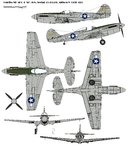I'm sure that Greg would just love this - I know I do 
Mike Williams has posted the flight test data about the XP-40Q-2. The plane made 422 mph, and was able to do ~420mph from 20000-26000 ft. All that on the F-27R engine, up to 3200 rpm and water injection. Mr. Whitney might want to update his book, since he does not states the engine's capabilities with ADI. For climb (= small 'ram'), the power at altitude on 'WER wet' regime was ~1690 HP at 17000 ft, and 1190 HP at 25000 ft.
The test: here; dated April 5th 1944.
So we eagerly await for the XP-40Q-3 tests
Mike Williams has posted the flight test data about the XP-40Q-2. The plane made 422 mph, and was able to do ~420mph from 20000-26000 ft. All that on the F-27R engine, up to 3200 rpm and water injection. Mr. Whitney might want to update his book, since he does not states the engine's capabilities with ADI. For climb (= small 'ram'), the power at altitude on 'WER wet' regime was ~1690 HP at 17000 ft, and 1190 HP at 25000 ft.
The test: here; dated April 5th 1944.
So we eagerly await for the XP-40Q-3 tests

